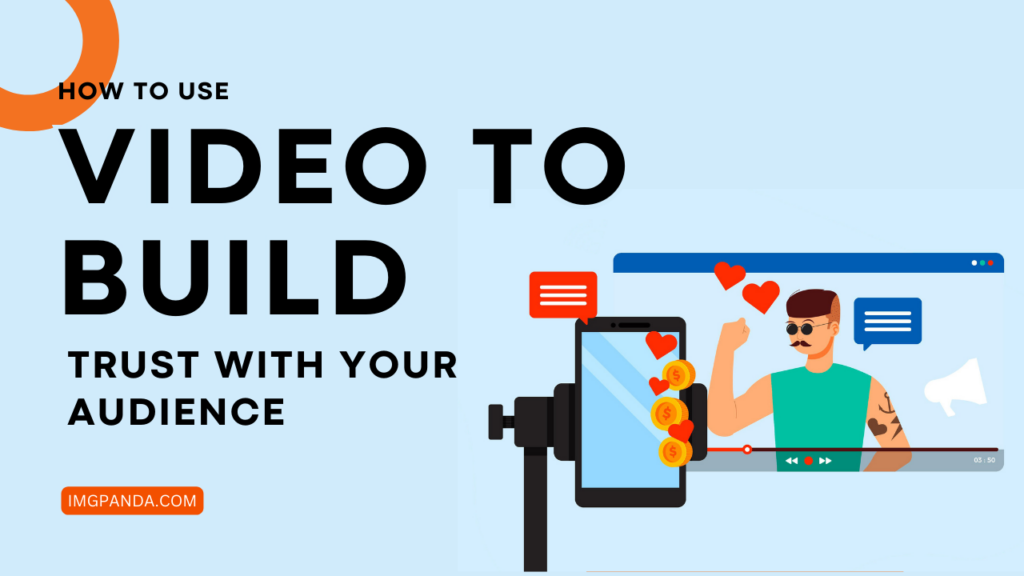Introduction
In today's digital world, building trust with your audience is essential for the success of any business or brand. People want to connect with brands and individuals they can trust and who have their best interests at heart. Video is a powerful tool that can help you establish and maintain trust with your audience.
In this blog post, we'll explore the benefits of using video to build trust, and provide you with actionable tips and strategies for creating high-quality video content that resonates with your audience and helps you establish trust. Whether you're a marketer, business owner, or content creator, this post will provide you with valuable insights and actionable steps to start using video to build trust with your audience.
Also Read This: Selling Pictures on EyeEm: A Photographer’s Guide
Understanding Your Audience
Before creating video content, it's important to have a clear understanding of your target audience. Understanding their needs, desires, and pain points can help you create content that resonates with them and establishes trust. Here are some steps to help you understand your audience:
Identify your target audience:
Who are you trying to reach? What are their demographics, interests, and behaviors? Conduct market research to gain insights into your target audience.
Create buyer personas:
Develop detailed buyer personas that represent your ideal customers. This will help you understand their motivations, goals, and pain points.
Understand their needs and pain points:
What are the challenges your target audience is facing? How can you help solve their problems? Create content that addresses their needs and provides value.
Create content that resonates with them:
Use language, tone, and visuals that appeal to your target audience. Make sure your content is relevant, informative, and engaging.
By understanding your audience, you can create video content that speaks directly to their needs, interests, and pain points. This will help you establish trust and build a deeper connection with your audience.
[caption id="attachment_182647" align="alignnone" width="2560"] Understanding Your Audience[/caption]
Understanding Your Audience[/caption]
Also Read This: Trial Takedown: How to Cancel Your iStock Free Trial
Creating High-Quality Video Content
Creating high-quality video content is essential for building trust with your audience. Here are some tips for creating compelling and professional-looking video content:
Plan your video content:
Before hitting the record button, plan your video content. Determine your video's purpose, message, and target audience. Create a storyboard or script to guide the filming process.
Use high-quality equipment:
Invest in quality video equipment such as a high-resolution camera, tripod, and microphone. This will ensure that your videos look and sound professional.
Lighting and sound:
Good lighting and sound are crucial for high-quality video content. Make sure you film in a well-lit area and use an external microphone for better audio quality.
Keep it short and sweet:
Attention spans are short, so keep your videos concise and to the point. Aim for videos between 1-3 minutes.
Edit your videos:
Edit your videos to remove any mistakes, add text, and adjust lighting and sound. Use video editing software such as Adobe Premiere Pro, Final Cut Pro, or iMovie.
By following these tips, you can create high-quality video content that engages your audience and helps you establish trust. Remember, quality over quantity. It's better to create a few high-quality videos than to produce a lot of low-quality ones.
[caption id="attachment_182648" align="alignnone" width="2560"] Creating High-Quality Video Content[/caption]
Creating High-Quality Video Content[/caption]
Also Read This: The Future of Images: Emerging Technologies and Their Impact on Visual Communication
Establishing Trust Through Video
Now that you know how to create high-quality video content, it's time to focus on using video to establish trust with your audience. Here are some strategies for building trust through video:
Be authentic:
Authenticity is key to building trust with your audience. Be yourself, and don't try to be something you're not. Share your personal experiences, opinions, and stories to connect with your audience on a deeper level.
Provide value:
Create video content that provides value to your audience. Offer solutions to their problems, share your expertise, or provide entertainment. When your audience sees that you're providing value, they'll be more likely to trust you.
Show social proof:
Social proof, such as testimonials or case studies, can help establish trust with your audience. Share customer success stories, reviews, or testimonials in your video content to show that your product or service is trustworthy.
Share your company culture:
By sharing your company culture through video, you can humanize your brand and help your audience connect with your team. Share videos of your team members, office space, or company events to show that you're more than just a business.
Be transparent:
Transparency is essential for building trust. Share behind-the-scenes footage of your business, show how your products are made, or provide a peek into your daily operations. By being transparent, you can establish trust and show your audience that you have nothing to hide.
By implementing these strategies, you can use video to establish trust with your audience and create a strong connection with your viewers. Remember, building trust takes time and effort, but it's worth it in the end.
[caption id="attachment_182649" align="alignnone" width="2560"] Establishing Trust Through Video[/caption]
Establishing Trust Through Video[/caption]
Also Read This: Alternatives to iStock: Exploring other platforms for royalty-free images and videos.
Optimizing Video for Trust Building
Optimizing your video content for trust building is essential to ensure that your videos are effective in establishing trust with your audience. Here are some tips for optimizing your videos for trust building:
Use clear and concise messaging:
Make sure your messaging is clear, concise, and easy to understand. Use simple language and avoid industry jargon or technical terms that your audience might not understand.
Incorporate visuals:
Visuals can help convey your message and make it more engaging. Use images, graphics, or animations to illustrate your points and break up the text.
Add captions and transcripts:
Captions and transcripts make your videos more accessible to a wider audience, including those who are deaf or hard of hearing. They also help with SEO by providing text for search engines to crawl.
Use a consistent brand voice:
Use a consistent brand voice across all your videos to establish a recognizable tone and personality. This will help your audience connect with your brand on a deeper level.
Engage with your audience:
Engage with your audience by responding to comments, answering questions, or hosting Q&A sessions. This shows that you value their input and care about their opinions.
Share your videos on social media:
Share your videos on social media platforms to reach a wider audience. This can help increase engagement, drive traffic to your website, and establish your brand as a thought leader in your industry.
By following these tips, you can optimize your video content for trust building and create a strong connection with your audience. Remember, building trust takes time and effort, but it's worth it in the end.
[caption id="attachment_182650" align="alignnone" width="2560"] Optimizing Video for Trust Building[/caption]
Optimizing Video for Trust Building[/caption]
Also Read This: Using WireImage for Event Promotion: A Guide for Marketers
Sharing and Promoting Video Content
Once you've created and optimized your video content for trust building, it's time to share and promote your videos to reach a wider audience. Here are some tips for sharing and promoting your video content:
Share on social media:
Share your videos on social media platforms like Facebook, Twitter, Instagram, and LinkedIn. Social media is a great way to reach a large audience quickly and easily.
Use paid promotion:
Use paid promotion to boost your videos' reach on social media platforms or run ads on Google or YouTube. This can help you reach a larger audience and increase engagement.
Embed videos on your website:
Embed your videos on your website to drive traffic and increase engagement. Make sure your website is optimized for video and has a dedicated video page.
Collaborate with influencers:
Collaborate with influencers in your industry to reach a wider audience. Influencers can help you promote your videos to their followers and increase your brand's visibility.
Share with your email list:
Share your videos with your email list to keep them engaged and informed. Include a call-to-action in your emails to encourage your subscribers to share your videos with their network.
Utilize video SEO:
Optimize your video content for search engines by using relevant keywords, titles, descriptions, and tags. This will help your videos rank higher in search results and increase visibility.
By following these tips, you can share and promote your video content effectively and reach a wider audience. Remember to track your video performance using analytics and adjust your strategy accordingly to ensure that your videos are effective in building trust with your audience.
[caption id="attachment_182651" align="alignnone" width="2560"] Sharing and Promoting Video Content[/caption]
Sharing and Promoting Video Content[/caption]
Also Read This: List of Top Cyber Security Linkedin Profiles
Pros & Cons
| Pros | Cons |
|---|---|
| Video can help establish a personal connection with your audience | Creating high-quality video content can be time-consuming and expensive |
| Video can help showcase your products or services in a more engaging way | Not all audiences may prefer video content and may prefer other forms of content such as written or audio |
| Video can help convey your message more effectively than written content alone | Some audiences may be skeptical of video content and view it as less trustworthy than other forms of content |
| Video can help establish social proof and increase trust in your brand | Poorly produced or low-quality video content can harm your brand's reputation and trustworthiness |
"Video is an incredibly powerful tool for building trust with your audience. It allows you to convey your message in a more personal and engaging way, and helps establish social proof by showcasing your products, services, or expertise. But creating high-quality video content that resonates with your audience takes time and effort. By understanding your audience, creating high-quality content, and optimizing your videos for trust building, you can establish a strong connection with your audience and build long-term trust in your brand." -Unknown.
Also Read This: How to Earn Money on Flickr – Easy Ways
Conclusion
In conclusion, using video to build trust with your audience can be a highly effective strategy for establishing a personal connection, showcasing your products or services, and conveying your message more effectively. By understanding your audience, creating high-quality video content, optimizing your videos for trust building, and promoting your videos effectively, you can establish a strong connection with your audience and build long-term trust in your brand.
Remember that building trust takes time and effort, so be patient and stay committed to creating valuable and engaging video content that resonates with your audience. With the right approach and strategy, video can be a powerful tool for building trust and strengthening your brand's reputation.
FAQs
What types of video content are best for building trust with your audience?
The best types of video content for building trust with your audience are those that showcase your products or services, convey your expertise or knowledge, and establish a personal connection with your audience. This can include product demos, customer testimonials, behind-the-scenes footage, educational content, and more.
How important is video quality when it comes to building trust with your audience?
Video quality is extremely important when it comes to building trust with your audience. Poorly produced or low-quality video content can harm your brand's reputation and trustworthiness, while high-quality video content can establish your brand as credible and trustworthy.
How can I optimize my video content for trust building?
You can optimize your video content for trust building by ensuring that it is relevant, engaging, and provides value to your audience. Use storytelling techniques to convey your message in a more personal and relatable way, and include social proof such as customer testimonials or endorsements to establish credibility and trust.
Can I use video to build trust with my audience on social media?
Yes, social media is a great platform for using video to build trust with your audience. You can share your videos on social media platforms like Facebook, Twitter, Instagram, and LinkedIn to reach a wider audience and increase engagement.
How can I measure the effectiveness of my video content in building trust with my audience?









































